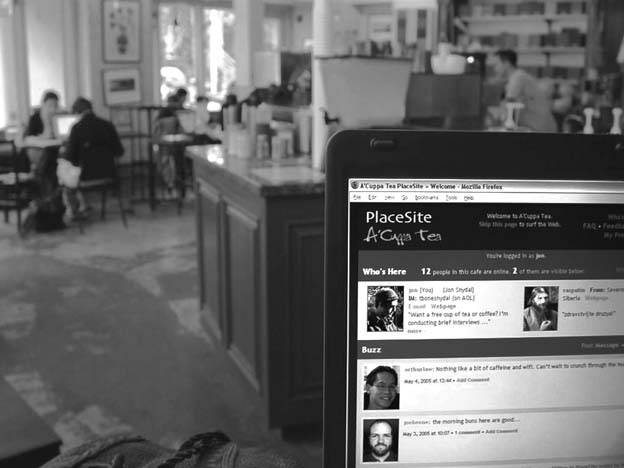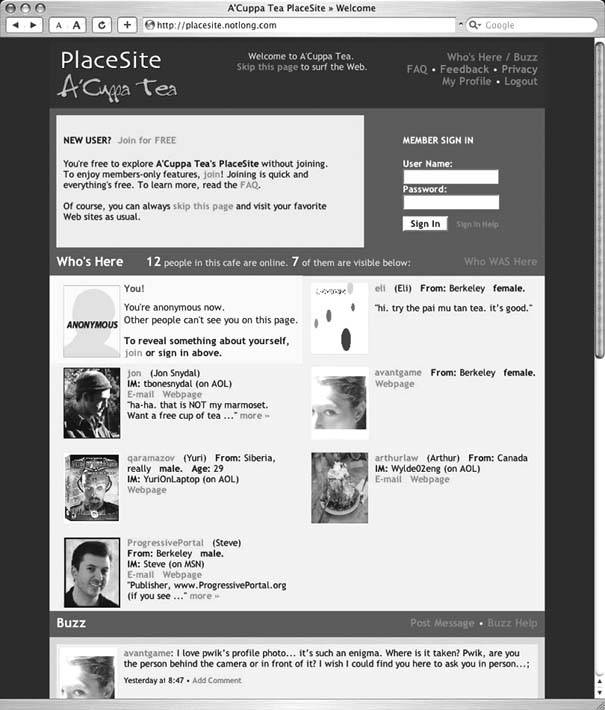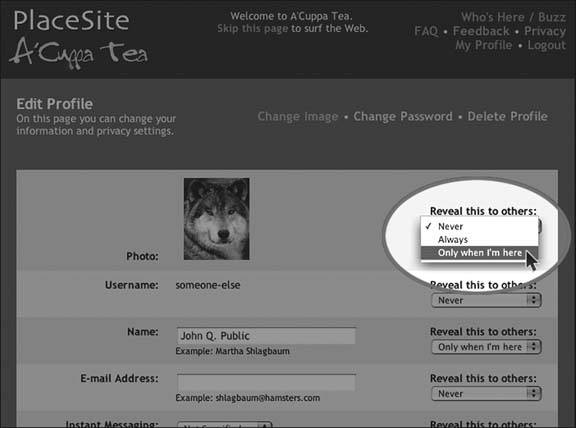Hack 76. Build an Online Community in Your Offline Neighborhood


Allow people in a café or other public Wi-Fi place to share information locally, apart from the global Web.
Wi-Fi is great for standard web and email access away from home. But take a closer look. That little router holds a world of opportunity that most people never consider.
Wi-Fi can:
- Connect people in a neighborhood, through web services tied intimately to a place.
- Offer an open venue for sharing digital information locally, which is a very different thing from publishing on the global Web (think: a chat with a regular at the local pub versus an interview with The New York Times).
- Provide a useful platform for location-based services that doesn't require participation by (or permission from) cellular carriers or Internet service providers.
You can work all this Wi-Fi mojo without forcing users to install any new hardware or software, and without requiring your favorite café owner (or other hotspot operator) to buy and maintain a server.
5.15.1. PlaceSite
Inspired by Sean Savage's research of Wi-Fi cafés at Intel Research Seattle in 2004, we (along with Jon Snydal) made PlaceSite our final Masters project at UC Berkeley. Marti Hearst at Berkeley's School of Information Management & Systems was our project advisor.
In May 2005, we launched an embryonic PlaceSite service in a Berkeley café, as shown in Figure 5-21. For a month, we studied how people used it and what they thought of it.
We think we're on to something.
Figure 5-21. PlaceSite running at A'Cuppa Tea café in Berkeley, California

5.15.2. The Core Components.
Two pieces make up the core PlaceSite service: the node (a Linksys Wi-Fi router running PlaceSite software) and the server.
|
5.15.2.1. The server.
We wrote the first version of the PlaceSite server code in JSP. The server requires the following code base:
- Tomcat 5.0.28 (http://jakarta.apache.org/site/downloads/downloads_tomcat-5.cgi) or later
- The latest stable release of MySQL 4.1 or greater (http://dev.mysql.com/downloads/mysql/4.1.html)
5.15.2.2. The node.
The PlaceSite node is a Linksys WRT54G router (available off the shelf for about US$50 as of July 2005) whose firmware has been replaced by the PlaceSite node software, which includes:
A specific version of OpenWRT [Hack #67]
A Linux distribution designed for the WRT54G. The code is downloadable at http://www.ilesansfil.org/tiki-list_file_gallery.php?galleryId=3.
|
WiFiDog
Open source captive portal software designed to let hotspot owners create splash pages, password prompts, and so on that appear when users hit their hotspots. The WiFiDog package can be found at http://old.ilesansfil.org/dist/WiFiDog.
Our modifications
They're under heavy development, but once they're stable, we'll make them available at http://placesite.com.
5.15.3. PlaceSite in Action
The modified router and server deliver location-specific content to every Wi-Fi client within range of that place's PlaceSite router.
When someone fires up a laptop in the place, starts a session, and opens a browser, the router informs the server of that person's presence. The server sends that place's current PlaceSite home page to the router, which transmits it to the person's browser. It's the first web page the person sees at the start of her session.
Figure 5-22 shows what this person might see in her browser.
Figure 5-22. A PlaceSite homepage as viewed by a new user

Now, the person can view message forums, create a profile, and view others' profiles. She can show and hide profile information from others on the fly, and she can specify that any piece of her information should be visible when she's present in the place but disappear when she's gone (i.e., when her Wi-Fi session in that place ends, as determined by a timeout triggered by a lack of activity). Figure 5-23 shows an example of how to reveal or hide information in a profile.
Figure 5-23. "Reveal" settings for personal information

Note that, in addition to user authentication (username/password login), the system provides place authentication: it serves up a node's content to everyone within range of that node's Wi-Fi router, and it serves that content only to those people. Currently, this authentication is performed via IP address, user token, and HTTP header validation. We are in the process of implementing a certificate-based authentication scheme. The router's contribution of simple place and presence data infuses traditional web services with powerful new benefits.
The real magic happens when many PlaceSite nodes talk to a single server, or to a federated group of servers that share live user and presence data. This forms a network of PlaceSite places and a platform that developers anywhere can build new location-based services on top of. Users can share their accounts across places, eliminating the need to reregister in each new place.
|
Views and communication between places become possible. Traditional web services (social networking/dating applications, mapping applications, local content providers, etc.) can hook into the platform's location and proximity data to dramatically boost the fun and usefulness of their offerings.
5.15.4. Setting Up Your Own PlaceSite
Follow the instructions from "Upgrade Your Wireless Router" [Hack #67] to install the OpenWRT firmware obtained from the WiFiDog project page. Once you have your firmware up and running, select the latest stable version of WiFiDog and install it via ipkg:
ipkg install http://old.ilesansfil.org/dist/WiFiDog/WiFiDog_1.1.1_mipsel.ipk
Once WiFiDog is installed, change the GatewayID option and setup an appropriate AuthServer section in the WiFiDog configuration file, /etc/wifidog.conf:
GatewayID PlaceSite
AuthServer {
Hostname yourserver.com
HTTPPort 8080
Path /path/to/PlaceSite/
}
To get the PlaceSite server set up, please see http://www.placesite.com for details. Since the public release of the code is imminent, any instructions we'd give you here are going to be out of date.
5.15.5. Running the Hack
Make sure that Tomcat and MySQL are running on the server and fire up WiFiDog on the node:
wifidog-init start
Associate your computer with the SSID of your WRT54G, open up your favorite web browser, and try to navigate to any web site. WiFiDog should grab your connection and redirect you to your own personal PlaceSite. Create an account, login, and have fun.
5.15.6. Troubleshooting the Hack
The first thing to check is whether or not WiFiDog can talk to your PlaceSite server. You can start up WiFiDog in a foreground mode with console debugging information to make sure that the connection is occurring correctly:
wifidog -d 7 -f
If it fails to talk to the PlaceSite AuthServer, check the values in your /etc/wifidog.conf file. Any other troubleshooting is beyond the scope of this hack, so consult the documentation for the relevant application.
5.15.7. Hacking the Hack
Now, open up your network to your community and use PlaceSite to get to know your neighbors. There's no limit to the ways you can customize your PlaceSite and remix it with other web services and with people, places, and things. Dig in.
At the time of this writing, we have three critical requests:
Keep the nodes connected
The more nodes that are linked together, the more useful the network will be for everyone. We strongly encourage you to link any nodes that you create into the wider network. Please visit http://www.placesite.com for the latest on how to accomplish this.
Respect users' privacy
While there's no such thing as complete privacy or security, we strive to never reveal data provided at one of our PlaceSite nodes beyond that place (either in other places or to other services or organizations)until the user who owns the data specifically requests that it be shared in such a way. You're free to do what you wish, but we strongly recommend that you also follow this policy. If you choose not to, please don't use the PlaceSite name and branding with your services.
Check in at placesite.com
I know, we're starting to sound like broken records. But by the time you read this, there are sure to be all sorts of new goodies and capabilities available so swing by and see what's cooking.
Sean Savage and Damon McCormick
Bluetooth, Mobile Phones, and GPS
- Hacks 122: Introduction
- Hack 1. Set Up Bluetooth on Linux
- Hack 2. Set Up Bluetooth on Windows XP
- Hack 3. Connect Mac OS X with a Bluetooth Phone
- Hack 4. Connect Linux with a Bluetooth Phone
- Hack 5. Connect Windows XP with a Bluetooth Phone
- Hack 6. Use Your Treo as a Modem
- Hack 7. Send SMS from a PowerBook
- Hack 8. Remote Control Mac OS X with Bluetooth Phones and PDAs
- Hack 9. Remote Control Linux with a Bluetooth Phone
- Hack 10. Control XMMS with Bluetooth
- Hack 11. Liven Up Parties with a Participatory Slideshow
- Hack 12. Send SMS from Linux
- Hack 13. Remote Control Windows with Bluetooth Phones and PDAs
- Hack 14. Control Your Bluetooth Phone with FMA
- Hack 15. Control Your Computer from Your Palm
- Hack 16. Control Your Home Theater from Your Palm
- Hack 17. Choose a Cellular Data Plan
- Hack 18. Blog from Your Mobile Phone
- Hack 19. Get Google Maps on Your Mobile Phone
- Hack 20. Share Your GPS
- Hack 21. Broadcast Your GPS Position
- Hack 22. Map Wi-Fi Networks with Kismet and GPSd
Network Discovery and Monitoring
- Hacks 2339: Introduction
- Hack 23. Find All Available Wireless Networks
- Hack 24. Discover Networks with NetStumbler
- Hack 25. Detect Networks with Handheld PCs
- Hack 26. Find and Join Wireless Networks with AP Radar
- Hack 27. Detect Networks on Mac OS X
- Hack 28. Scan Passively with KisMAC
- Hack 29. Detect Networks with Kismet
- Hack 30. Monitor Wireless Links in Linux with Wavemon
- Hack 31. Analyze Traffic with Ethereal
- Hack 32. Track 802.11 Frames in Ethereal
- Hack 33. Watch Network Traffic
- Hack 34. grep Your Network
- Hack 35. Check Wi-Fi Network Performance with Qcheck
- Hack 36. Estimate Network Performance
- Hack 37. Get Real-Time Network Stats
- Hack 38. Graph Your Wireless Performance
- Hack 39. Find Radio Manufacturers by MAC
Wireless Security
- Hacks 4051: Introduction
- Hack 40. Stop Moochers from Stealing Your Wi-Fi Bandwidth
- Hack 41. Visualize a Network
- Hack 42. Secure Your Linux Network with WPA
- Hack 43. Control Wireless Access by MAC
- Hack 44. Authenticate Wireless Users
- Hack 45. Forward Ports over SSH
- Hack 46. Proxy Web Traffic over SSH
- Hack 47. Securely Connect Two Networks
- Hack 48. Generate a Tunnel Configuration Automatically
- Hack 49. Poll Wireless Clients
- Hack 50. Interrogate the Network
- Hack 51. Track Wireless Users
Hardware Hacks
- Hacks 5262: Introduction
- Hack 52. Add an External Antenna
- Hack 53. Do-It-Yourself Access Point Hardware
- Hack 54. Boot from a Compact Flash Hard Drive
- Hack 55. Increase the Range of a PowerBook
- Hack 56. Send Power over Your Ethernet
- Hack 57. The NoCat Night Light
- Hack 58. Upgrade the Linksys WET11
- Hack 59. Scan for Wireless Networks Automatically
- Hack 60. Backlight Your Zipit
- Hack 61. Unwire Your Pistol Mouse
- Hack 62. Mobilize Your WRT54G with the WiFiCar
Software Hacks
- Hacks 6382: Introduction
- Hack 63. Build Your Own Access Point with Linux
- Hack 64. Bridge Your Linux AP
- Hack 65. Protect Your Bridge with a Firewall
- Hack 66. Filter MAC with HostAP and Madwifi
- Hack 67. Upgrade Your Wireless Router
- Hack 68. Set Up an OLSR Mesh Network
- Hack 69. Extend Your Wireless Network with WDS
- Hack 70. Pebble
- Hack 71. Wall Off Your Wireless
- Hack 72. Run Your Mac as an Access Point
- Hack 73. Run Linux on the Zipit Wireless Messenger
- Hack 74. Capture Wireless Users with NoCatAuth
- Hack 75. Capture Wireless Users on a Small Scale
- Hack 76. Build an Online Community in Your Offline Neighborhood
- Hack 77. Manage Multiple AirPort Base Stations
- Hack 78. Advertise Bonjour Services in Linux
- Hack 79. Advertise Any Service with Bonjour in Mac OS X
- Hack 80. Redirect Brought to you by Bonjour Ads
- Hack 81. Use a Windows-Only Wireless Card in Linux
- Hack 82. Use Your Orinoco Card with Hermes AP
Do-It-Yourself Antennas
- Hacks 8393: Introduction
- Hack 83. Make a Deep Dish Cylindrical Parabolic Reflector
- Hack 84. Spider Omni Antenna
- Hack 85. Pringles Can Waveguide
- Hack 86. Pirouette Can Waveguide
- Hack 87. Primestar Dish with Waveguide Feed
- Hack 88. Primestar Dish with Biquad Feed
- Hack 89. Cut a Cable Omni Antenna
- Hack 90. Build a Slotted Waveguide Antenna
- Hack 91. The Passive Repeater
- Hack 92. Determine Your Antenna Gain
- Hack 93. Build Cheap, Effective Roof Mounts
Wireless Network Design
- Hacks 94100: Introduction
- Hack 94. Analyze Elevation Profiles for Better Long-Range Wireless Networking
- Hack 95. Build a Wireless Network for the Large House
- Hack 96. Establish Line of Sight
- Hack 97. Calculate the Link Budget
- Hack 98. Align Antennas at Long Distances
- Hack 99. Slow Down to Speed Up
- Hack 100. Take Advantage of Antenna Polarization
Appendix A. Wireless Standards
- Appendix A. Wireless Standards
- Section A.1. 802.11: The Mother of All IEEE Wireless Ethernet
- Section A.2. 802.11a: The Betamax of the 802.11 Family
- Section A.3. 802.11b: The De Facto Standard
- Section A.4. 802.11g: Like 802.11b, only Faster
- Section A.5. 802.16: WiMAX Long Distance Wireless Infrastructure
- Section A.6. Bluetooth: Cable Replacement for Devices
- Section A.7. 900 MHz: Low Speed, Better Coverage
- Section A.8. CDPD, 1xRTT, and GPRS: Cellular Data Networks
- Section A.9. FRS and GMRS: Super Walkie-Talkies
- Section A.10. 802.1x: Port Security for Network Communications
- Section A.11. WPA & 802.11i
- Section A.12. BSS Versus IBSS
Appendix B. Wireless Hardware Guide
EAN: 2147483647
Pages: 178


